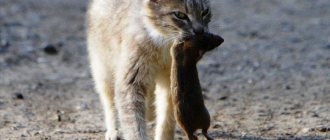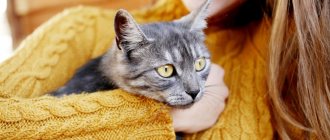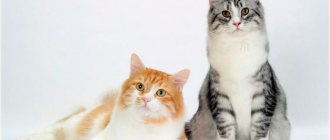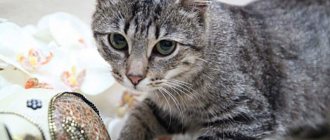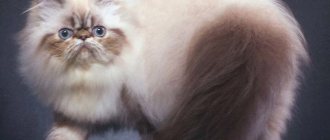The exotic cat is the closest relative of the Persian cat. Being a representative of an exotic breed, she deservedly takes leading places at various titled exhibitions.
The exotic cat breed has captivated many with its expressive, wide-open eyes. Excellent characteristics of the breed standard, as well as unpretentious animal care, allow you to raise a healthy pet.
History of the origin of the breed
The exotic cat originated in the United States in the 1960s. The main task facing breeders at that time was to diversify the color. A silver Persian cat was selected for crossing. However, the result was typical Persian cats that had plush short hair.
They were so charming that in 1966 the American breeder Jane Martink identified them as a new breed, the Sterling. Later they began to be called an exotic shorthair cat.
Innovative breeders Doris Walkingstick (from the Grayfire nursery) and Caroline Bussain (from the New Dawn nursery) crossed Persians not only with American Shorthairs, but also with Russian Blues and Burmese.
In 1973, with the appearance in the standard of a characteristic feature - snub nose, the breed was brought even closer to the Persians. From the early 1990s to the present day, the Persian and Exotic have an identical standard: innovations are introduced equally to both breeds.
Description and breed standard
The breed of exotic shorthair cat duplicates all the parameters of the Persian cat standards except for the length of the coat. The description of the breed first of all represents its main parameter – the eyes. The exotic extreme subspecies of the breed is characterized by a depressed nose and has the most beautiful coat color.
The characteristics of exotics have the following standard:
- Head. Large rounded muzzle with a snub nose and pronounced cheeks. Exotics have forward-facing small ears. Large eyes set wide apart. Eye color depends on the color of the cat. Exotic Extreme, like Persian Extreme, has a small depressed nose, which is located between the inner corners of the eyes.
- Wool. Plush exotics contain silky short body hair up to 2 cm long, and also have a good thick undercoat.
- Color. The color variations are different: from black to light. In addition to the monochromatic color, it combines 2-3 shades, and is distributed in the form of spots of various sizes.
- The body is of medium length reaching 25-30 cm at the withers. Muscular and rounded bones with a strong lumbar region and a voluminous chest.
- The limbs are short with thick paws.
- The tail is small and densely pubescent.
- Weight. The female’s body weight is 4-5 kg, the male’s is up to 7 kg.
Exotic shorthair cat
The Exotic Shorthair cat comes from representatives of the popular breeds – Persian and American Shorthair. In appearance, this is a British Shorthair, which is almost indistinguishable in terms of structural features. The main difference between exotic cats and British cats is their flattened nose, as well as their affectionate and friendly character.
Many breeders were concerned about the bone quality of the exotic breed, which they tried to improve over the years. The American representative surpassed the results of crossings and added massive bones and thick paws to the exotic cat. Peculiarities of the breed: caring for exotic cats does not require much effort and time.
Exotic Longhair
Exotic longhaired cat is a side effect of crossbreeding that appeared after the identification of shorthaired exotics. Unlike the short-haired breed, it has long, thick hair and the same structure.
Description of extreme Persians
With its charming flattened face and short upturned nose, the extreme Persian cat visually resembles Pekingese dogs, which is why its name is Peke Faced (extreme “curvature” as a result of which the bridge of the nose is above eye level, and the nose is located above the inner corners of the eyes).
Persians look very unusual: a short, depressed nose, and due to the special structure of the muzzle, the eyes seem slightly bulging. This animal looks very touching and cute, you just want to hold a furry baby in your arms!
The body of cats is plump, squat, the head is round, with small pointed ears. The main pride of the Persians is, of course, their rich, lush “coat” with a well-developed, thick and dense undercoat. The coat is long and silky. The most common colors are red and beige.
INTERESTING TO KNOW: Oriental cats: description and maintenance features
Color
The exotic cat has a variety of colors that combine different shades:
- Black. Does not contain any other shades.
- Marble. Presented in the form of stripes. It has additional shades: beige with the addition of red; combination of gray and black.
- Blue. A gray tint is added to the color.
- White. White perfection.
- Ginger. A beige tint has been added to the color.
- Red tabby. With a bright red tint all over the back.
Chocolate exotic is considered one of the rarest representatives of the breed. Includes a coffee shade and the color of tree bark in the color palette of the coat.
What does a Persian cat look like?
The general impression that emerges after meeting the Persian leaves no doubt about the amazing similarity of the cat to the Pekingese.
An upturned nose and a flattened muzzle are the calling card of the breed. From a photo of a Persian cat you can immediately unmistakably identify the breed. The maximum weight of an adult animal is 7 kg. Depending on the place of breeding, there are two varieties of Persian cats: classic (European) and extreme (American). They differ in the length of their fur and the size of their nose. The nose of “extreme” Persians is at or above the midline of the eye, and their coat is shorter than that of “classic” Persians.
Muzzle
Persians have a dome-shaped skull and a large head. The round and wide muzzle has thick cheeks and powerful cheekbones. The stop line is well defined. According to the standard, the description of the head includes:
- small ears with rounded tips and pubescent auricle;
- large and round eyes, widely spaced from each other;
- wide and short nose;
- well-developed jaws and a weak chin, forming a straight line with the nose and forehead.
Persians have very long whiskers and are considered the pride of cats.
Body type
What does a Persian cat look like? The head is located on a short and muscular neck. Animals have strong bones and developed muscles. The width of the croup and massive shoulders differs by a couple of centimeters. The squat body ends in a short and thick tail, rounded at the tip. It is covered with fluffy fur along its entire length.
The body is supported by short but powerful hind and forelimbs. There are tufts of long hair between the toes.
A disadvantage of the breed is considered to be the knobby tail of the stumpy type, found in Manx cats.
Coat and color
Cats have a thick undercoat and a soft, thin coat. On the neck, chest and shoulders, the fur reaches a maximum length of 14 cm. The standard allows any known colors of the Persian cat:
- plain (black, white, blue, red, cream);
- tortoiseshell (the color is typical for girls, but for boys it is considered an anomaly);
- silver (smoky, chinchilla);
- marble (the pattern of stripes and rings resembles stains on marble);
- color point and other points.
A Persian's coat determines what color its eyes will be. The most common color is red. This color is typical for any color. Blue eyes are a distinctive feature of color-point cats, and green eyes are a distinctive feature of Persians with a golden or silver coat. Representatives with white coats often have heterochromia. One eye gets an orange tint, and the other gets a blue tint.
Despite the variety of acceptable colors, a pet can be disqualified if there is a “medallion” on its chest.
Wool
Exotics look like soft plush kittens. Their coat is soft, thick and silky to the touch, and contains a palette of all traditional colors. The quality of a cat's hair depends on genetic predisposition, proper care and a balanced diet.
Short-haired exotics have short hair. Unlike the British and American breeds, they have thick hair. Their undercoat is so dense that when parted with your hands it is quite difficult to see the skin.
The Longhaired Exotic has long hair, like the Persians. An uncontrollable negative factor for animals is shedding, which they experience with complete loss of undercoat.
Breeding Persian cats
Many people dream of owning a cat that can be bred in the future. However, this process is complex and requires a lot of knowledge. Not all individuals are allowed to do this, but only those that belong to the show class. Kittens obtained from such parents are highly valued. It is also necessary to have documents for animals, to know their pedigree and genetic predispositions.
Breeding the breed itself will require a lot of effort, time, and financial expenses from a person to provide their pets with the proper level of care.
Features of mating Persians
Mating in cats takes place in the dark. It is accompanied by a period of acquaintance and courtship. As a rule, the female is in the territory of her partner. Sexual maturity in this breed occurs at 7-9 months. The specific time depends on the care of the animal and its physiological characteristics. The female is usually ready to breed at 6-8 months, and the males at 8-10 months.
Castration and sterilization
Castration or sterilization is carried out according to the rules and requirements common to all cats. This event is a full-fledged surgical intervention, especially in females, so it is important to provide the animal with the necessary care.
Character and temperament
The character of the exotic shorthair cat appeals to all animal lovers. Pets have an open, understanding look and a barely audible voice. Such ideal character traits of an exotic will appeal to many who value calm and affectionate pets.
They have no bad manners at all, they do not fight with other animals. But they require more attention, since they really like to be surrounded by company and cannot stand loneliness.
They play with children warily, but without aggression. The animals are very attached to their households, but do not pester their owners and patiently wait until they pay attention.
Exotic care
Exotic shorthair kittens do not require special care from the moment they appear in the family. They love to be the center of attention of their owner. Caring for exotics is quite easy if you follow a certain sequence.
Caring for your pet's eyes deserves the most daily attention, as the breed is susceptible to the disease epiphora. To monitor your pet's health, it is necessary to undergo regular examinations with a veterinarian.
The following care measures should be taken for pets:
- bathing with a special dry shampoo should be carried out once every 3 months;
- periodically trim the tips of the claws;
- comb the coat with a special brush once a week;
- remove watery eyes using a sterile swab moistened with eye product;
- clean ears once every 2 weeks;
- clean and sanitize the animal's tray and house.
Caring for an animal takes no more than 10-15 minutes: daily for fur and face; once every 2 weeks to treat claws, teeth and ears.
Only proper care and daily care for an exotic animal, carried out by the owners, will exceed all expectations and help raise a full-fledged animal, which in return will give all its love and devotion.
What to feed an exotic cat
It is better to give your pet premium dry food, which can be purchased at any pet store. The hunting instinct of an exotic cat is rare; it can catch a mouse, which it perceives as a funny toy.
What is the price
You can find out how much an exotic costs only in a professional nursery or from breeders who have all the necessary documents for their pets. The cost of an exotic cat is quite high; few people breed this rare breed in our country.
While searching for advertisements on the Internet, you may come across scammers selling short-haired Persians at a price reduced by 2-3 times.
Shorthaired exotic kittens from professional breeders are purebred, with a confirming pedigree and vaccination record. The average price for kittens ranges from $300 to $1,200.
Persian cat price
The price of a Persian breed kitten can be very varied. It depends on the rarity of the color, the quality of the coat, age, gender, breeder requirements, pedigree and other factors. Of course, color can also affect the cost; for example, a pure white Persian cat may cost more than an animal with color errors.
It is advisable to buy a Persian cat only after checking all the documents of the cat and the breeder. The cost of a cat on average can vary from 2,000 to 30,000 rubles. Of course, the lower the cost, the greater the likelihood of acquiring a Persian cat with errors in the pedigree.
Kitten in the house
An exotic kitten needs comfort and care; the animal must have its own cat corner. For your pet, you need to pay maximum attention to secure your place of residence: to avoid accidental falls, put nets on all windows. It is necessary to feed an exotic kitten natural food, including meat and dairy products.
From a very early age, breeders teach kittens the rules of feeding. There should be small portions according to the age of the pet. Kittens are fed 3-4 times a day. To prevent obesity and poisoning, you should wean the kitten from sticking its curious muzzle to the common table.
Names for cats of an exotic smooth-haired breed are selected in accordance with distinctive features: the color of the coat and eyes; the nature. Cat nicknames come up with bright ones with the presence of whistling sounds, and adding affectionate suffixes.
- Nicknames for boys' cats are invented based on his character and behavior. The boy can be called Marquis, Pegasus or Athos.
- You can name a girl kitten with a beautiful exotic name, for example, Isa or Silva.
These cute exotics will become true members of the family, bringing comfort and warmth to the home atmosphere. An exotic kitten is a funny plush toy for any child; from the first days it will decorate the life of any family for many happy years.
